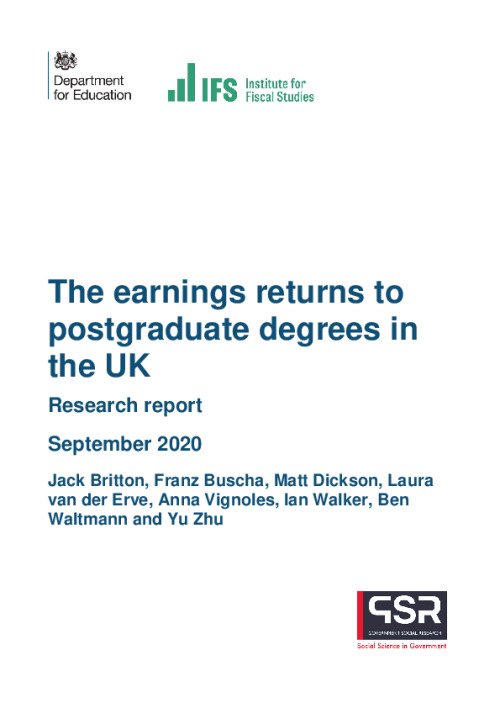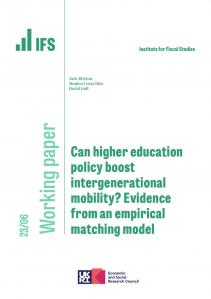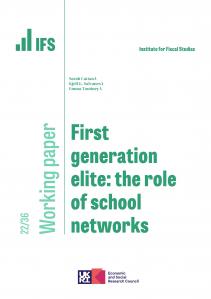This report provides estimates of the earnings returns to completing postgraduate degrees, for British and Northern Irish students studying in Britain. We use the Longitudinal Education Outcomes (LEO) data set to account for differences in individuals’ background and prior university attainment to estimate the impact of postgraduate qualifications on earnings at age 35, relative to having an undergraduate degree and not proceeding to further study.
We use age 35 for our headline estimates in order to allow people to gain sufficient labour market experience after completing their qualifications. We also show how these returns evolve throughout individuals’ 30s. We look separately at returns for masters, PhD and Postgraduate Certificate in Education (PGCE) degrees, and break these down by gender, prior undergraduate degree, postgraduate institution, and (where appropriate) postgraduate subject. Following our previous reports, we estimate the earnings impact for individuals in sustained employment, though we additionally consider the effect on the probability of being in sustained employment and earning above certain thresholds. We focus on individuals who started their undergraduate degree by age 21 and define postgraduates as those who have completed a full-time postgraduate qualification by age 30.
While this work dramatically improves on the existing evidence in this area, some caution needs to be exercised when interpreting these findings. First, this report focuses on the private earnings returns to postgraduate qualifications only. Second, while we have a very rich data set that allows us to control for many of the differences between those who do and do not attend postgraduate courses, there may still be unobservable differences between individuals which we cannot control for, such as differences in motivation or preferences over occupations or working hours. Third, our main estimates focus on the earnings return at age 35. To the extent that earnings patterns of graduates of different postgraduate degrees may diverge from those for individuals with only an undergraduate degree beyond this age, these returns may look different later in the life cycle. Finally, our main estimates are necessarily based on individuals who graduated from their undergraduate degree between the mid 1990s and the mid 2000s. It is important to recognise that returns might be very different for current undergraduate students due to compositional and labour market changes. With these caveats in mind, we outline our main findings below.
Who does postgraduate degrees and what are they studying?
• More and more people are proceeding to postgraduate study. More than 350,000 students now start a postgraduate course in the UK each year, compared with only around half this number 20 years ago.
• Men are slightly more likely to progress to masters degrees and PhDs than women, while women are far more likely to go on to do PGCEs. Those studying for PhDs and PGCEs are disproportionately white, but the composition for masters degrees is more representative of the undergraduate population.
• Students studying for postgraduate qualifications tend to have done very well in their undergraduate degree. Virtually all PhD students, and around 70% of masters students, obtained a first-class or 2:1 undergraduate degree, compared with around 50% for those whose highest qualification is an undergraduate degree. PGCE students look much more similar to undergraduates, albeit with slightly fewer first-class degrees and slightly more 2:1s.
• Individuals from more privileged backgrounds are much more likely to do a postgraduate degree, but this can virtually all be explained by prior attainment in school and at university. Even accounting for these differences, however, differences remain in the type of postgraduate course attended, with individuals from less advantaged backgrounds being more likely to do a PGCE.
• Masters degrees and PhDs are overwhelmingly taken at Russell Group and pre-1992 universities, with those two groups accounting for around half of undergraduate students, but around 95% of PhDs and 70% of masters degrees.
• Arts and humanities students are less likely than STEM students to study for a masters or PhD, but are much more likely to do a PGCE. Science, technology, engineering and maths (STEM) and law, economics and management (LEM) students make up around three in every four masters and PhD students, even though they only account for just over 60% of those on undergraduate degrees. Two subjects – biosciences and chemistry – account for around one in four of all PhD students.
What are the average earnings returns to postgraduate degrees by age 35?
• For both men and women, masters and PhD graduates earn more on average than those with only an undergraduate degree, while PGCE graduates earn less on average. In particular for men this last gap is large, with PGCE graduates earning around £38,000 on average at age 35 compared with nearly £51,000 for those with only an undergraduate degree. For both genders, earnings growth through the 30s is largest among undergraduates and PhD graduates and smallest for PGCE graduates.
• Earnings inequality varies widely across qualification groups, with very few PGCE graduates experiencing very high earnings, but also many fewer experiencing low earnings compared with those who left education after their undergraduate degree. As a result, despite the large differences in mean earnings, median earnings of PGCE graduates are very similar to those of undergraduates for men, and even somewhat higher for women.
• Once we control for differences between students, the earnings gap between undergraduate and masters and PhD graduates drops significantly: we estimate returns of 2% (women) and -2% (men) for masters and 8% (women) and -9% (men) for PhDs.
• For PGCEs, accounting for differences in background and undergraduate attainment has the opposite effect, primarily due to PGCE students having studied undergraduate subjects with lower earnings potential on average. We get a final estimate of the returns to PGCEs at age 35 of -2% for men and +1% for women.
• Our estimated returns for postgraduate degrees are considerably smaller than previous estimates from the UK, which have been consistently positive. We believe this is because we have much richer data than have previously been available, which allows us to much better control for differences between postgraduates and undergraduates.
• PGCEs are a relatively ‘safe’ choice for both women and men: they reduce the chances of not being in employment, as well as earning less than £30k, but decrease the probability of earning more than £40k. We see quite similar patterns for PhD degrees, as well as for masters degrees for women. Perhaps this is because these degrees tend to result in people pursuing specific interests, such as research, where salaries are reasonable, but which are not necessarily the most exceptionally lucrative careers. For men, masters degrees do not offer this insurance value.
How do the returns to masters and PhDs vary by subject, institution and prior qualifications?
• The overall estimates obscure important heterogeneity in returns across subjects. Around a third of masters subjects yield statistically positive returns for women. LEM subjects give the highest returns of around 20% at age 35, but courses such as creative arts, English and philosophy lead to earnings more than 10% lower than those of similar individuals who did not pursue a postgraduate qualification.
• Returns for men by masters subject are lower, with statistically significant negative returns at age 35 for most subjects. However, LEM subjects and engineering still yield strongly positive returns for men. When looking at PhD degrees, there are some notable differences in the subject ordering, such as PhDs in maths having remarkably low returns and psychology being one of the highest-return PhDs for both genders.
• By institution, returns for masters degrees range from less than -20% for a handful of institutions at the bottom end, to upwards of 20% at the top. However, much of these differences are driven by the subject offering of each institution, with many of the institutions at the top having large shares of students studying high-return courses such as law, while the institutions at the bottom tend to specialise in low-return arts, music and drama courses.
• Prior study is also important. For individuals who have graduated from a relatively low-returning undergraduate course, the best option for maximising earnings is to diversify: while these individuals often see negative returns to a masters in the same subject, returns to a masters degree in a different field are overwhelmingly positive, both for men and women. Students who graduated with a degree in a relatively high-paying subject, such as economics, law, business or some of the STEM subjects, tend to do best by sticking with their subject at masters level, while switching can be particularly costly. These estimates might seem like the most pertinent for prospective postgraduate students choosing a course.
• Overall, we find that for students of nearly all undergraduate subjects, there are some masters subjects they can take that lead to positive returns – even for men, who see very low returns overall.
How do the returns to PGCEs vary by institution and prior qualifications?
• Among PGCE graduates, we observe significant heterogeneity across undergraduate subjects. Notwithstanding the large negative average returns to PGCEs, for both men and women graduates of a handful of subjects – including sports science and creative arts – have large and significant positive returns to PGCEs. On the other hand, economics, law and maths graduates have large negative returns to PGCEs of -20% or more, due to the very high counterfactual earnings for this group.
• Unlike for masters and PhDs, PGCE graduates from Russell Group universities tend to have the lowest estimated returns, which is likely driven by the higher prior attainment – and hence higher counterfactual earnings – of these students and by the limited pay differentials in teaching.
• These low returns might explain the patterns of selection into PGCEs, and indeed teacher recruitment challenges: PGCEs are most prevalent among English, sports science and philosophy graduates, and much less prevalent for many STEM and LEM subjects.
Find out more and read the full report on the Gov.UK website here.













